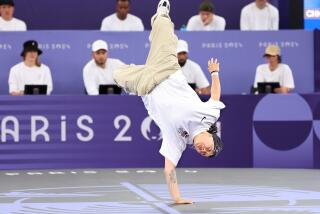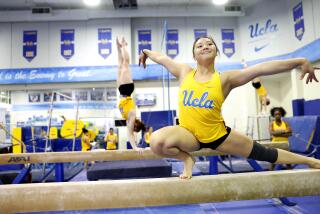Feminine physique
- Share via
AMID the oversized bulging, veiny muscles of female bodybuilding -- and what some dismiss as women’s heads plopped on men’s bodies -- comes a competition for the less ... intense.
The look is still muscular and cut. Competitors must have strong definition in their upper bodies, abs and legs, emphasized by exceptionally low body fat -- but without the heavy striation and veining seen in bodybuilding.
Called “figure” competition, the division is new to the bodybuilding circuit, but growing -- fast. Some early amateur competitions about five years ago brought out 75 women; now the same shows draw 200-plus.
“It’s a boomer, I’ll tell you what,” said Jim Manion, president of the National Physique Committee, an amateur bodybuilding federation (the professional arm is the Ben Weider-founded International Federation of Bodybuilding & Fitness). “It’s done so well. And it keeps women in the gym training.”
Although the bodybuilding and hard-core fitness worlds didn’t embrace figure competition at first, it’s now welcomed with bear hugs. The physiques are attainable by almost any woman -- without the help of banned substances -- and the sport is praised for providing a more palatable image of fit, strong women.
As it continues to expand and attract mainstream audiences, figure competition might even change the image of hard-core bodybuilding.
In figure competition, the emphasis is on the feminine. Curves are compulsory. Competitors wear high heels, makeup, jewelry, sparkly swimsuits, and in some contests, evening gowns. Facial beauty is prized. The division emerged on the scene when numbers for fitness competitions started dropping several years ago, according to Manion. In those contests, competitors show off not only their physiques (still not as big as bodybuilders), but also perform a demanding aerobic routine. Once a mainstay of ESPN programming, fitness competitions began to dwindle because of a limited pool of women who have cut biceps, can do 20 one-handed push-ups and look awesome in a bikini.
Also, women who had competed for years were experiencing overuse injuries but were still looking for a way to stay in the game. Promoters were looking for a way to keep bodies on stage and ticket sales up.
But the evolution was also prompted by a reaction to female bodybuilders’ physiques, according to Steve Downs, chairman of the World Natural Bodybuilding Federation, a pro group that also includes figure (the amateur wing is the International Natural Bodybuilding Federation).
“In bodybuilding,” he said, “as the athletes became leaner with more emphasis on muscularity, even in the natural ranks, women themselves weren’t that enthralled with it.” Figure, he adds, allows training, discipline and competition without the blown-up physiques.
This new category also eliminates the justification for anabolic steroids and other muscle-enhancing substances, long tied to bodybuilding. Though there is talk of drug use among figure competitors (including diuretics and ephedra), many in the industry say the sport has far less abuse than bodybuilding.
“It doesn’t make a lot of sense for women to be taking steroids in figure,” Manion said. “We don’t get many people in the audience saying, ‘Wow, that girl’s been juicing.’ ” Random drug testing is done in the NPC and the IFBB, he adds, “but figure is the least we worry about in terms of steroids.”
Figure competition appeals to women such as Gina Aliotti, a 21-year-old San Diego State student who’s been athletic her entire life and started competing when her father, a bodybuilder, suggested it. They did their first show together in 2004.
“I’ve always had a more athletic build, and growing up with girls who are really thin, it was nice to be appreciated for the body type I had,” she said. More contests followed, and Aliotti earned her pro card last year.
Recently, a couple of days after her first pro figure competition in Colorado (where she placed seventh out of 24), Aliotti was back at World Gym, a no-frills San Diego gym where she trains. Her contest-ready physique is cut, with little body fat. Her upper arms have definition but aren’t immense, abs are chiseled, and legs reveal strong quad and calf muscles. She’s often mistaken for a sprinter. She stands 5 feet 4, with a contest weight of 129, and 138 off-season.
The bodybuilding route was never tempting. “I never wanted to do that,” she said. “That’s not the look I liked. I want to stay feminine and have feminine lines and curves. I never wanted to be that muscular. It was just a turn-off.” She wants to keep competing professionally, training clients, and after she graduates, plans to become a physician’s assistant.
As Aliotti goes through a typical routine, it’s apparent that her workout isn’t about pushing tons of weight. She does shoulder presses with 20-pound dumbbells -- more than most women would hoist -- but on leg extensions she lifts only 30 pounds, and on tricep kick-backs she uses 15-pound dumbbells. By contrast, female bodybuilders might lift 75 pounds on leg extensions, and use 25 pounds on kick-backs. Workouts, even pre-contest, aren’t hours-long torture sessions. A focused weight workout could last about 35 to 45 minutes; a bodybuilder might spend two hours.
The diet she follows is stringent but allows for foods such as peanut butter, lean meats and whole grain breads. Meals are stricter pre-contest, and off-season she allows herself a “cheat” meal once a week.
Aliotti credits her trainer, Kim Oddo, for this everything-in-moderation approach. Oddo, who owns Body By O, a training facility in Murrieta, started training figure competitors in 2000, and now has a roster of 300 to 400 figure clients, including Monica Brant, considered one of the top figure competitors in the country.
“The minute figure started, I loved it,” said Oddo, a former competitive bodybuilder. “I thought this was a great thing to get an everyday mainstream American into conditioning.”
In the beginning, figure competitors had only vague guidelines of not being too muscular and having good muscle symmetry. Even today, although the parameters have gotten more specific, some are still confused about what the ideal figure physique should look like -- and it can change, depending on the contest, the judges and the competitors, from softer and less muscled to extraordinarily lean and cut.
Figure competitors, like bodybuilders, hope for prize money, modeling gigs and sponsorships to help defray costs. Many, like Aliotti, become trainers. But prize money in figure is paltry compared with bodybuilding. In the WNBF, said Downs, prize money this year for bodybuilding will be $60,000; for figure, $12,000.
That will undoubtedly increase, some in the industry say, as the sport grows.
Figure competition is now an accepted part of the bodybuilding world, observers say, even though it encountered early resistance from more extreme bodybuilders. “It’s been a very positive thing because it’s brought people into our sport who normally wouldn’t compete,” Smith said.
In recent years, Smith said, judges have even been looking for less musculature from female bodybuilders as well. “I believe the look they’re trying to achieve is something that’s aesthetically pleasing across the board,” she said, perhaps opening the door to bigger contracts with more middle-of-the-road supplement and clothing companies and publications.
“They’re trying to appeal more to the mainstream. It’s where the money is.”
More to Read
Sign up for The Wild
We’ll help you find the best places to hike, bike and run, as well as the perfect silent spots for meditation and yoga.
You may occasionally receive promotional content from the Los Angeles Times.






